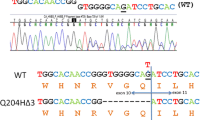Abstract
Acute intermittent porphyria (AIP) is an autosomal dominant disorder caused by a partial defect of the heme biosynthesis enzyme, porphobilinogen deaminase (PBGD). PBGD is encoded by two distinct mRNA species expressed in a tissue-specific manner from a single gene. One transcript is expressed in erythroid tissues, while the housekeeping transcript is expressed in all tissues. In classical AIP (95% of cases) the housekeeping and the erythroid-specific enzymes both have half-normal activity in erythroid and non-erythroid tissues, whereas in the variant non-erythroid form of the disease the enzymatic defect is present only in non-erythroid cells. A large allelic heterogeneity of mutations (n>135) has been demonstrated in classical AIP, but to date only three different mutations have been characterized in the non-erythroid variant form of AIP. We describe the molecular abnormalities responsible for the non-erythroid variant form of AIP in two French and two German unrelated AIP patients with normal PBGD activity in the erythrocytes. Three different splicing defects located in the intron 1 donor splice site were identified: a 33+1 g→a mutation, previously described in a Dutch family, was found in two patients; two novel mutations (33+2 t→a, 33+5 c→g) affected the two remaining patients. All the mutations resulted in the activation of a cryptic splice site 67 bp downstream in intron 1, leading to a frameshift and a premature stop codon in exon 4. Mutations in the exon 1 donor splice site are involved in eight of the nine non-erythroid variant AIP families reported in the literature. These data show that most mutations causing the non-erythroid variant AIP are exon 1 splice defects, in contrast with classical AIP, where missense mutations are chiefly involved. Moreover, the allelic heterogeneity of PBGD gene defects causing the non-erythroid variant AIP is demonstrated, with five different mutations identified. These mutations could be easily detected by a single denaturing gradient gel electrophoresis which also allows the presymptomatic detection of gene carriers in the affected families.
Similar content being viewed by others
Author information
Authors and Affiliations
Additional information
Received: 1 June 1998 / Accepted: 22 July 1998
Rights and permissions
About this article
Cite this article
Puy, H., Groß, U., Deybach, J. et al. Exon 1 donor splice site mutations in the porphobilinogen deaminase gene in the non-erythroid variant form of acute intermittent porphyria. Hum Genet 103, 570–575 (1998). https://doi.org/10.1007/s004390050871
Issue Date:
DOI: https://doi.org/10.1007/s004390050871




